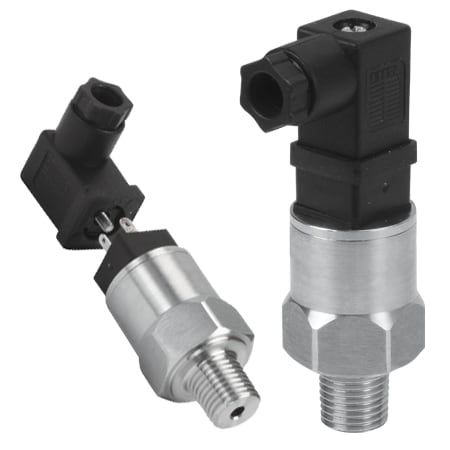A pressure transducer, often called a pressure transmitter, is a transducer that converts pressure into an analog electrical signal. Although there are various types of pressure transducers, one of the most common is the strain-gage base transducer.
The conversion of pressure into an electrical signal is achieved by the physical deformation of strain gages which are bonded into the diaphragm of the pressure transducer and wired into a wheatstone bridge configuration. Pressure applied to the pressure transducer produces a deflection of the diaphragm which introduces strain to the gages. The strain will produce an electrical resistance change proportional to the pressure.
Pressure transducers use strain gauges to measure the force acting on them. The strain gauges undergo deformation and this creates a change in voltage produced by it. The pressure measurement is based on the degree of change seen in the voltage.
There are also advanced versions of pressure transducers that use capacitance or piezoelectric sensors instead of the strain gauges. They are chosen based on the range, work environment and precision required from the pressure sensor.
Learn More
Pressure transmitter? Pressure transducer? Pressure sensor? Pressure switch? When searching for devices that work with pressure, you will come across many terms that can be confusing to someone new to space. What are they and how are they different from each other?
Understand the differences reading the next article.
Learn More
Accuracy, hysteresis, resolution, span,… selecting a pressure sensor can be confusing.
Understanding the specifications of data sheets when a pressure transducer needs to be selected is critical to choose a correct model for your application.
In the following article these specs are explained.
Learn More
Are you still wondering how to decide what type of pressure transducer or pressure transmitter you need?
To learn more about the criteria you should think about when making your decision, the next article, Practical Considerations when Choosing a Pressure Transducer will help you pick out the right device for your application.
Learn More
There are a number of a factors that will impact the price of a pressure transducer. The biggest differentiator is whether you can use a standard, off-the-shelf pressure transducer or if you need a custom pressure transducer.
For an off-the shelf pressure transducer, pressure transducer prices will be most affected by the level of accuracy required for your application. The more accurate, typically the more expensive the pressure transducer.
To learn more about the pricing of custom pressure sensors read the next article.
Learn More
Pressure transducers are of the greatest utility for industrial and laboratory data acquisition and control applications. While the number of applications are almost as limitless as the types of pressure transducers, here are some of the most common applications our customers use pressure transducers for:
1. Measuring inlet, outlet or system pressure in engine test setup
2.Measuring pressure drops in a line for preventive maintenance
3.Measuring fluid height or level in tanks
4. Measuring the pressure of slurry/slush using a flush diaphragm pressure transducer
5.Sanitary pressure transducers in the bio or pharmaceutical industry.
Learn More
As far back as Galileo Galilei, scientists have been trying to measure pressure. For almost the next three hundred years, scientist would make discoveries that helped inform their understanding of pressure measurement. However, it wasn’t until 1930, with the invention of an unbonded strain gauge by Roy Carlson, a civil engineer, that big strides were made with pressure transducer technology.
1930: Roy Carlson designed the first unbonded wire strain gauge to measure the strain inside a concrete structure.
1938: Arthur Ruge, Massachusetts Institute of Technology, and Edward Simmons, California Institute of Technology, independently but simultaneously develop a process for a bonded wire strain gauge. The two men ended up applying for a patent together.
1952: Foil strain gauges were invented by Peter George Scott Jackson of Saunders-Roe Ltd. Foil strain gauges provided advantages over bonded wire gauges, including better heat dissipation, better thermal stability, better reproducibility, and lower production costs.
1954: The capacitive pressure transducer was developed by Carl Spaulding. These sensors provided a way to measure very small pressures with sufficient accuracy.
1960s: The first thin-film transducers with good stability and low hysteresis were developed. The technology remains in use today for measuring high pressure. Meanwhile, silicon diaphragm and silicon sensor patents were also developed in the late 1960s by Art Zias and John Egan of Honeywell Research Center.
1973: William Polye of Bendix Corporation designed a capacitive transducer using quartz. This made it possible to measure lower pressure ranges.
1979: Robert Bell of Kavlico built on the capacitive transducer technology to replace the quartz body with a ceramic one. This design remains commonly used today.








